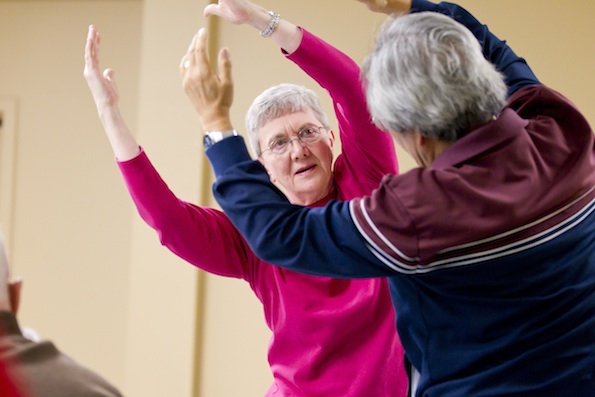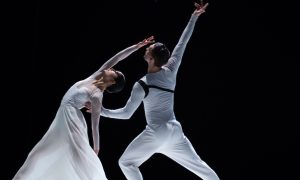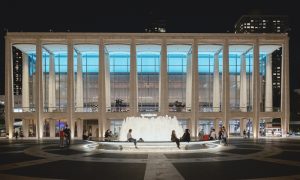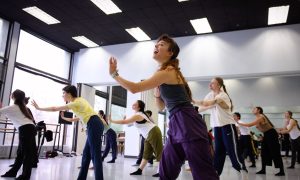Classes provide rich experience for participants
By Chelsea Thomas.
Renowned year-round contemporary dance company Hubbard Street Dance Chicago, now in its 35th season, can constantly be seen touring both nationally and internationally. Yet, in the past few years, the company’s local dance studio, Lou Conte Dance Studio, has begun to garner similar national attention for its phenomenal public dance programs.
With over 70 classes offered per week to youth and adults, Lou Conte Dance Studio is a hub of physical activity and movement. Yet one program stands out amidst the others – The HSDC Parkinson’s Project.
“The Parkinson’s Project is a set of classes offered for adults with Parkinson’s disease. The program is about five years old now and has been steadily growing,” says Kathryn Humphreys, Director of Hubbard Street Education’s Youth and Community Programs.
Parkinson’s disease, a degenerative neurological disorder, affects the central nervous system and causes movement-related symptoms, usually including shaking, muscle rigidity, slowness of movement, difficulty walking and postural instability. While there is no cure for it yet, physical therapy has been proven to help curb some symptoms. With this in mind, HSDC’s program uses contemporary dance techniques to work to slow the progress of the disease.
Like other programs that have sprung up across the country, such as the well-known Dance for Parkinson’s Disease that is led by the Brooklyn Parkinson Group and the Mark Morris Dance Group, the program seeks to create a positive atmosphere where participants can improve mobility and overall well-being.
“First and foremost it’s a dance class. It is not focused on their disease as much as their interest in dance,” Humphreys explains. “The participants looking to be involved are typically interested in this not feeling like a therapy… Not that they don’t find it therapeutic, but mostly, they like to think of it as something they do for themselves and not for the disease.”
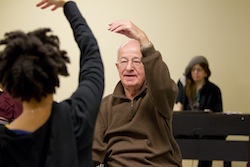
A student participating in Hubbard Street Dance Chicago Parkinson’s Project in 2011. Photo by Todd Rosenberg.
Classes, which are offered twice weekly and on the third Saturday of every month, are taught by Sarah Cullen Fuller and Kristen Gurbach Jacobson. Fuller, a former Hubbard Street dancer and the program’s founding teaching artist, says the program focuses on dance experimentation in “improvisational techniques and personal narratives.”
“We approach class with an open mind and with a strong desire to continue to improve and push boundaries along the way,” Fuller explains. “We understand that our participants are challenged with their disease, but we also aim to see them through a dance lens. In other words, we acknowledge the disease, but it does not drive us from a pedagogical point of view.”
“Like many dance classes, there is a huge spectrum of movement abilities in the room, and it is our job to help to develop new skills and trust in the process, regardless of limitations.”
Jacobson, also the Hubbard Street Youth and Family Programs Manager, says a typical class first starts with “a check-in, or a time of greeting and getting everyone acquainted” since the program is so community-centered. Then it immediately dives into one of Hubbard Street Education’s most important components, the BrainDance. This is an idea originally developed by Chicago educator Anne Green Gilbert.
“The BrainDance focuses on moving through breath and the cross-lateral connection, which is like walking,” Jacobson explains. “The idea is that by re-patterning our bodies from the outside we can better connect them to what’s happening inside, both emotionally and mentally. It’s a really fitting exercise to do with our participants.”
Jacobson says this section of class has become one of her favorite moments “because they’re beginning to connect to their bodies again, and maybe they haven’t all week long until that point.” After this, the class goes into a warm-up, followed by a standing combination “somewhat akin to the ballet barre” and an improvisation session, to finally conclude with a group combination.
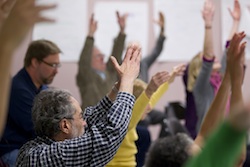
Participants dancing in a HSDC Parkinson’s Project class. Photo by Todd Rosenberg.
While the class is mostly taught with the participants sitting in chairs, Jacobson clarifies that the movement is much more than “just arm circles.” By the end of the class most of the students can be seen standing and dancing across the floor.
“As they move with the live musical accompaniment they slowly begin to increase their range of motion without necessarily thinking about it,” Humphreys recounts. “Many participants say that they feel much more fluid when they are dancing. They don’t feel so conscious of their movement. Rather, they feel like dancers, confident and comfortable.”
Fuller says that the “tight-knit” community built through the dance classes usually makes a way for trust and in response, greater physical confidence. “This trust is evident in the risks that they take each and every class. These are dancers who walk or wheel into the room and who may have difficulty getting to class, but who also flourish, learn, grow and develop new skills through dance. It’s really such a beautiful thing. Moving with a group of people with whom you trust, value and love is truly transcending.”
About 70 students and caregivers are currently registered with the program and Jacobson estimates that more than 150 have been involved in the last five years. The only program like it in Chicago, The Parkinson’s Project is also the oldest of its kind in the Midwest. But what’s the neatest part? Perhaps that the program is completely free to participants.
Fuller summarizes the heart of The Parkinson’s Project, saying, “We are all on this journey with one another, bound together through our love of dance.”
For more information on The Parkinson’s Project, visit www.hubbardstreetdance.com. Contact the HSDC Education and Community Programs Department at 312-850-9744 x149 if you or someone you know might be interested in attending a class.
Photo (top): Two dancers participating in a class as a part of Hubbard Street Dance Chicago Parkinson’s Project. Photo by Todd Rosenberg.


